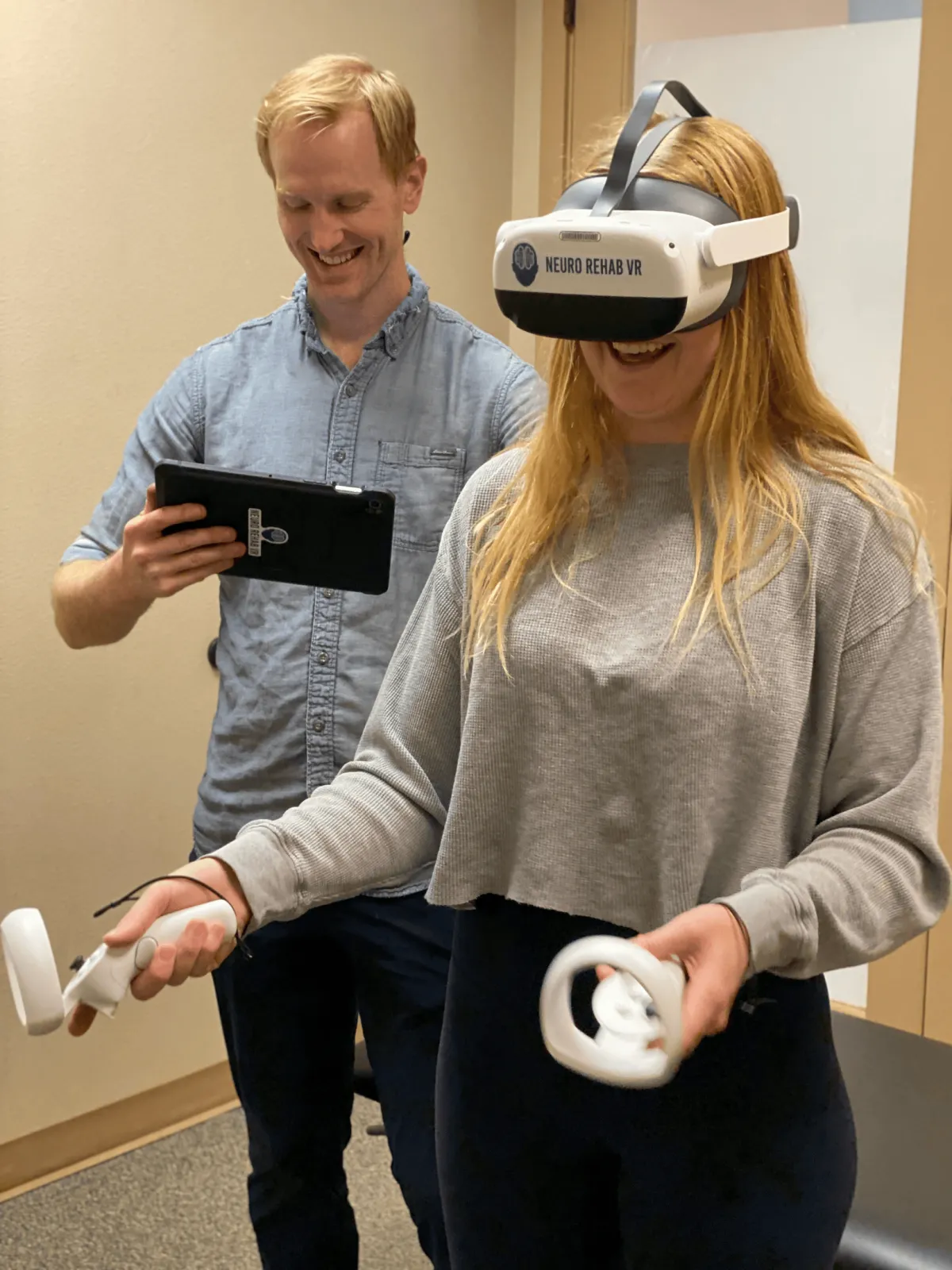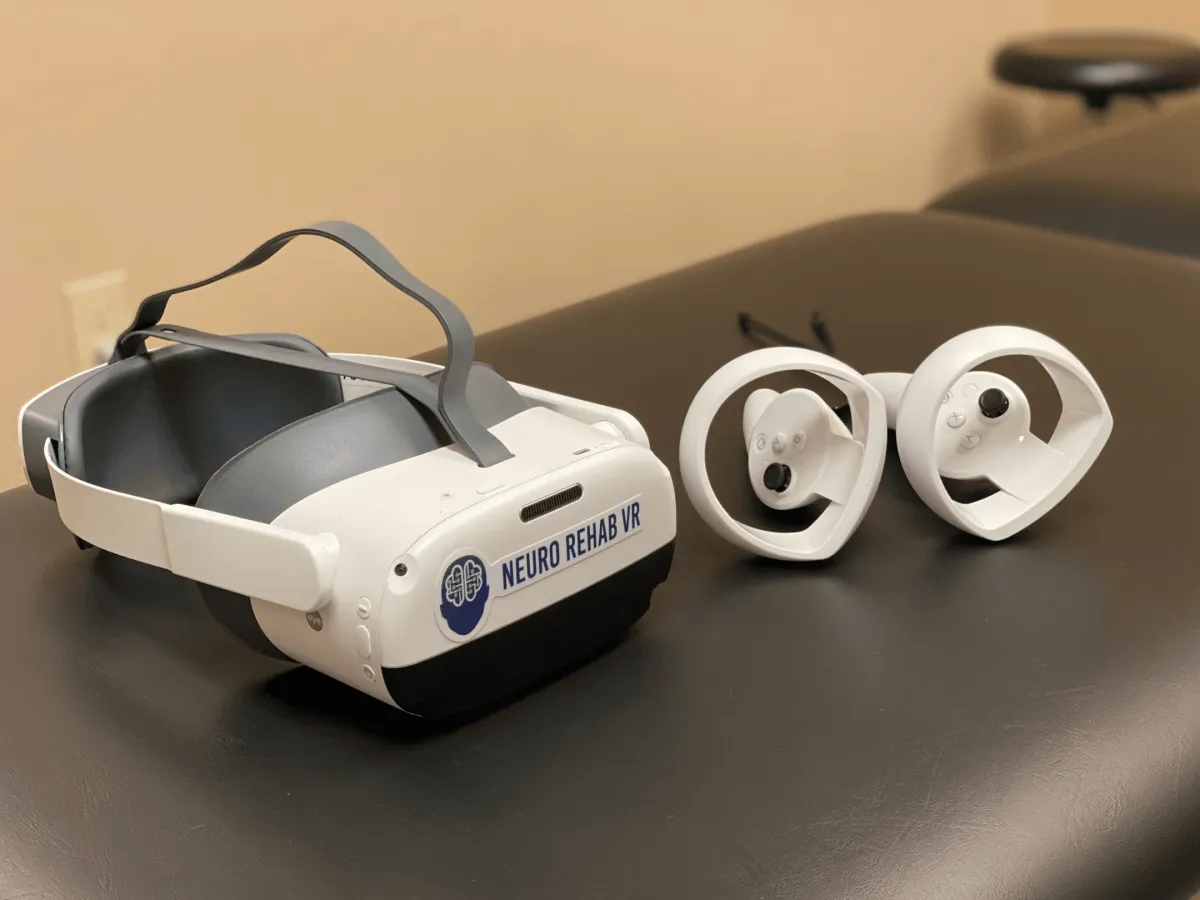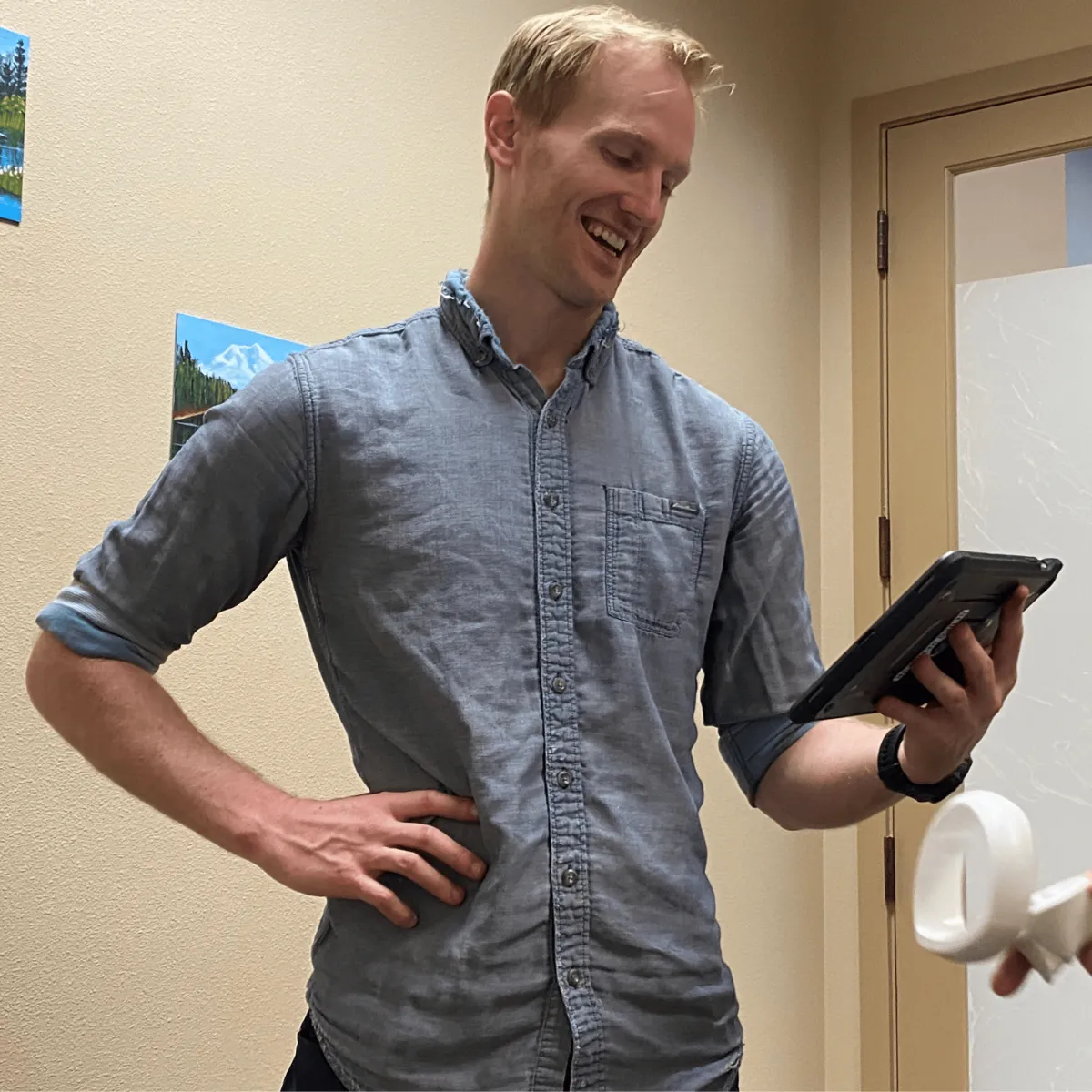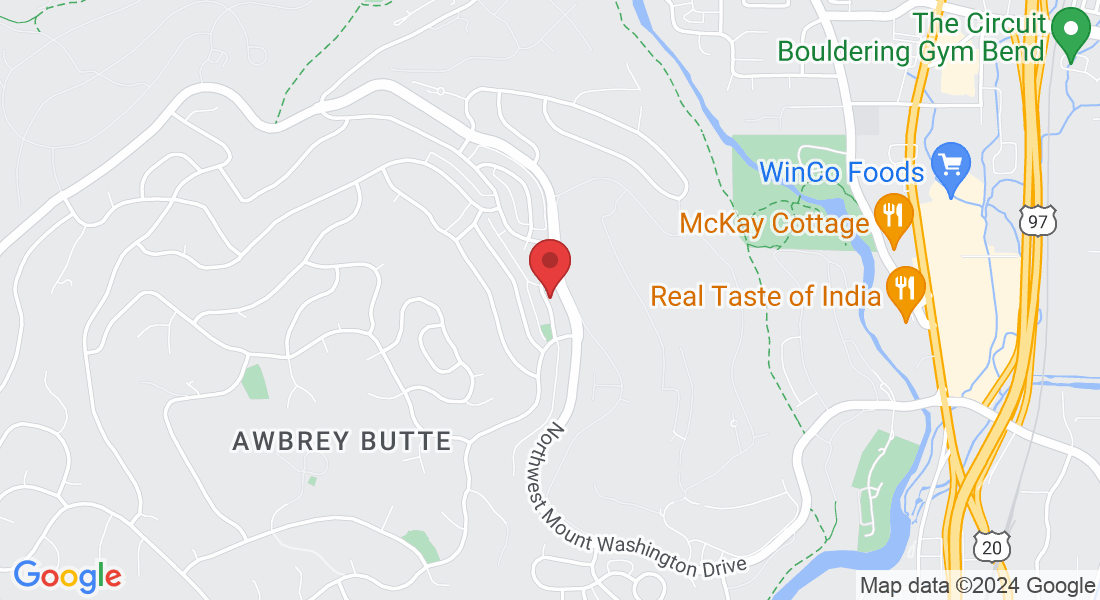Virtual Reality Physical Therapy
Virtual Reality Physical Therapy: A New Era of Healing at PhysioFIT
At PhysioFIT, we believe in embracing the latest advancements in physical therapy to provide our clients with unparalleled care. Our Virtual Reality Physical Therapy program is at the forefront of this innovative approach, blending cutting-edge technology with the expert guidance of Tanner Sommers, PT, DPT. This immersive experience not only enhances the healing process but also brings a level of engagement and precision to rehabilitation that was once unimaginable.

The Advantages of VR Physical Therapy
Immersive Engagement: With VR, you're not just doing exercises; you're playing games designed to help you heal, making the time fly by.
Precise Rehab Exercises: VR allows for pinpoint accuracy in therapy, helping to ensure each movement is contributing to your recovery.
Motivating Feedback: Instant feedback from the VR system encourages you to keep going, showing you how far you've come and where you're headed.
Customized Therapy Environments: VR can simulate environments and scenarios tailored to the patient's therapy goals, allowing for a customized experience that can adapt to their progress and preferences.
Enhanced Cognitive Engagement: By stimulating both the body and mind, VR therapy can help improve cognitive functions alongside physical abilities, leading to a more comprehensive rehabilitation process.
How Does Virtual Reality Physical Therapy Work?
Virtual Reality (VR) Therapy at PhysioFIT operates on the foundational concept of neuroplasticity—the brain's remarkable ability to reorganize itself by forming new neural connections throughout life. This ability is harnessed through repetitive practice and stimulation. Here's how our system takes advantage of this principle to aid in rehabilitation:
Multisensory Stimulation: Our VR system engages multiple senses simultaneously. By stimulating the vestibular system (which deals with balance), vision, proprioception (the awareness of body position and movement), cognitive functions through multitasking, and providing both haptic (touch) and auditory feedback, the therapy creates a rich environment for the brain to build new pathways. This multisensory approach is key to creating a robust and effective rehabilitation experience.
Task-Specific Training: The VR programs at PhysioFIT are designed to support task-specific training. This means the activities and games within the VR environment are tailored to help patients regain skills and abilities relevant to their daily life, work, or recreational activities. Whether it's returning to a sport or just the ability to perform daily tasks, the VR training is focused on practical and meaningful outcomes.
Customized Therapy Sessions: Our therapists, equipped with in-depth knowledge and tools provided by the VR system, have the capability to control and customize each aspect of the user experience. They ensure that each session is not only effective but also meets the specific challenges and therapy goals of the patient. This customization is critical to providing a session that is both beneficial and engaging for the patient.
Artificial Intelligence and Machine Learning: Neuro Rehab VR's system incorporates advanced technologies such as artificial intelligence (AI) and machine learning (ML) within its games and exercises. These technologies enable the system to automatically adjust to the patient's level of ability and progress. As the patient interacts with the system, AI algorithms analyze performance and dynamically adapt the difficulty and type of exercises in real-time. This ensures that patients are constantly challenged at an appropriate level for their current abilities, promoting optimal recovery and engagement.
The Power of Neuroplasticity: By utilizing VR therapy, we're tapping into the brain's plasticity to make recovery from injury a more dynamic and accelerated process. The goal is to create an environment where the patient can repeatedly perform targeted movements and tasks, leading to stronger neural connections and, ultimately, better motor function.
In essence, the VR therapy system at PhysioFIT is not just a set of exercises; it's a sophisticated, adaptable, and personalized therapy tool designed to engage the brain's natural ability to heal and adapt, ensuring that each patient can achieve the best possible outcomes in their rehabilitation journey.
Neuro Rehab VR: Our Technology Partner
Our partnership with Neuro Rehab VR, a Texas-based trailblazer in VR therapy solutions, enables us to offer the most advanced VR therapy system available.
Neuro Rehab VR's XR Therapy System is a clinically validated and FDA-registered platform that transforms patient care through immersive games and activities tailored to each patient’s therapy plan. The system includes:

Latest Technology: The XR Therapy System revolutionizes the therapeutic experience with state-of-the-art VR equipment, including headsets, controllers, and a specialized tablet for seamless control and interaction.
Comprehensive Care: Therapists can provide immersive and adaptive care with customized games and activities that cater to each patient's specific needs and abilities.
Data-Driven Results: A proprietary Data Analytics Portal allows for the measurement, tracking, and quantification of patient progress, ensuring targeted and efficient therapy outcomes.
Neuro Rehab VR has distinguished itself through extensive research and development, resulting in over 30 different activities and use cases ranging from stroke recovery to balance enhancement. The versatility of their system supports a wide demographic, including neuro rehab, orthopedics, geriatrics, and pediatrics, backed by over three decades of research confirming the effectiveness of VR in various aspects of rehabilitation
.
The XR Therapy System is celebrated for its ease of integration into clinical workflows, making it a turn-key solution for modern physical therapy practices. With its comprehensive design, therapists at PhysioFIT can control and guide the patient experience with a companion tablet, while also utilizing robust data analytics to track and quantify each patient's progress.
Furthermore, Neuro Rehab VR has garnered significant acclaim, including press coverage and industry accolades, for their innovation and contributions to healthcare technology. Their presence extends across various healthcare facilities in the U.S., from hospitals and outpatient clinics to senior living facilities, demonstrating their system's wide acceptance and success

Meet Tanner Sommers, PT, DPT - Your Virtual Reality Expert
Tanner Sommers is a leading physical therapist at PhysioFIT who expertly combines his extensive education in Exercise Science and Physical Therapy with advanced certifications in EMG/NCV and Level III dry needling. His innovative approach to rehabilitation is highlighted by his leadership in Virtual Reality Physical Therapy, utilizing Neuro Rehab VR's pioneering technology.
Certified in VR rehabilitation, Tanner is adept at creating immersive, personalized therapy sessions that prioritize patient engagement and holistic recovery. His commitment to integrating the latest in therapeutic innovation with compassionate care ensures that every patient is on a path to regain their fullest potential, making PhysioFIT a hub for forward-thinking physical therapy in Bend.
Please Note: The information provided on our website is intended for general education and is not a substitute for professional medical advice. Each individual's situation and body is different. Therefore, what may work for one person may not work for another. We care about your well-being and advise you to reach out to us to discuss your specific needs before implementing any advice from our website.
Your Source for All Things Physical Therapy in Bend Oregon
The PhysioBlog

Top 5 Mistakes After Knee Replacement
Top 5 Mistakes After Knee Replacement
Please Note: The information provided on our website is intended for general education and is not a substitute for professional medical advice. Each individual's situation and body are different. Therefore, what may work for one person may not work for another. We care about your well-being and advise you to reach out to us to discuss your specific needs before implementing any advice from our website. If you’d like to explore this more or would like to schedule a time with a physical therapist in Bend Oregon, contact us at PhysioFITBend.com
Introduction
Navigating Knee Replacement Recovery in Bend, Oregon
In Bend, Oregon, knee replacement surgery is more than a medical procedure; it's a journey towards a pain-free, active lifestyle. At PhysioFIT, we understand this journey intimately. While knee replacement can be life-changing, the path to recovery is critical. Missteps can delay healing and impact outcomes. This article explores the top five mistakes to avoid after your surgery, ensuring your recovery is as effective and smooth as possible.
Mistake 1: Overlooking Post-Surgery Lifestyle Adjustments
Preparing Your Home and Life for Recovery
Adapting your living space for post-surgery recovery is crucial. Many patients underestimate the limitations they'll face immediately after surgery. At PhysioFIT, we encourage patients to consider home modifications, such as arranging a ground-floor living space and preparing easy-access meal options. We provide personalized consultations to help our Bend community prepare their homes and lives for the recovery phase.
Mistake 2: Inconsistent Pain Management
Effective Pain Control: A Cornerstone of Recovery
Managing pain is not just about comfort; it's about enabling active participation in rehabilitation. Irregular use of prescribed pain medication can lead to a debilitating cycle of discomfort and hindered mobility. At PhysioFIT, our pain management strategies are tailored to each individual, ensuring a balance between relief and recovery.
Mistake 3: Neglecting Physical Therapy and Exercise
The Role of Rehabilitation in Knee Recovery
Physical therapy is the bedrock of successful knee replacement recovery. Skipping sessions or not fully committing to the exercise regimen can result in stiffness and reduced mobility. Our PhysioFIT experts design customized therapy plans, keeping in mind the unique lifestyles of our Bend clients, ensuring that each step in the therapy process is both manageable and effective.

Mistake 4: Rushing Back into Activities
Finding the Right Pace for Activity Post-Surgery
The eagerness to return to normal life can lead to overexertion, causing setbacks in recovery. Understanding the fine line between necessary activity and overdoing it is essential. Our PhysioFIT team guides patients in gradually resuming activities, balancing rest and movement to foster optimal healing.
Mistake 5: Skipping Pre-Surgery Conditioning
The Impact of Prehab on Recovery Outcomes
Pre-surgery conditioning, or prehab, plays a significant role in enhancing post-surgery recovery. Building strength and flexibility prior to surgery can lead to better post-operative outcomes. Our prehab programs at PhysioFIT are designed to prepare your body for the demands of surgery and speed up the recovery process.
Conclusion
Join PhysioFIT for a Successful Knee Replacement Journey
Avoiding these five common mistakes can significantly influence your recovery after a knee replacement. Remember, each decision and action during your recovery can greatly impact the overall success of your surgery. If you're in Bend, Oregon, and preparing for or recovering from knee replacement surgery, PhysioFIT is here to guide you every step of the way. Visit PhysioFIT or call us to schedule a consultation. Let's work together towards a successful recovery and a return to the active, pain-free life you love.
Frequently Asked Questions
Navigating Common Concerns After Knee Replacement
What is the most commonly reported problem after knee replacement surgery?
The most commonly reported issue is stiffness or limited range of motion in the knee. Regular physical therapy and exercises are crucial to prevent and address this problem.
What can you never do after knee replacement?
High-impact activities such as running, jumping, or contact sports are generally discouraged after a knee replacement as they can put excessive stress on the new joint.
What are the red flags after total knee replacement?
Red flags include severe pain that doesn’t improve with medication, significant swelling, redness around the surgery site, fever, or any signs of infection. Any of these symptoms should prompt immediate medical consultation.
What is the maximum bend after knee replacement?
The goal is typically to achieve a range of motion close to 115 degrees, which is sufficient for most daily activities. However, the maximum bend can vary based on individual factors and the type of replacement used.
Please Note: It's important to note that any exercises or techniques that are shared should be performed under the guidance of a qualified physical therapy expert to ensure correct technique and to prevent injuries. A physical therapist can provide a customized exercise program based on the individual's fitness level, goals, and any existing injuries or conditions. If you’d like to explore this more or would like to schedule a time with a physical therapist in Bend Oregon, contact us at PhysioFITBend.com
Copyright PhysioFIT 2023 . All rights reserved


